Intel P965: Mid-Range Performance Sector Roundup
by Gary Key on October 20, 2006 9:00 PM EST- Posted in
- Motherboards
ASUS P5B-E: Board Layout and Features
After viewing the Abit AB9-Pro, the layout on the ASUS seems almost mundane. However, we have no real complaints about the layout except for the location of the IDE port and 24-pin ATX power connector. We feel like the IDE port connector should have been placed next to the floppy drive connector or replaced it. It would have been nice to have the 24-pin ATX connector located further to the right behind the memory slots. The motherboard was very easy to install and remove from our case. The four fan headers were within easy reach and can be controlled by the Q-Fan utility. The P5B-E replaces the P5B model. We tested both the 1.01G and 1.02G revision level boards and they are identical except for the BIOS changes and a PLL controller. Both boards feature an excellent three-phase voltage regulator power design along with high quality capacitors that yielded exceptional stability.
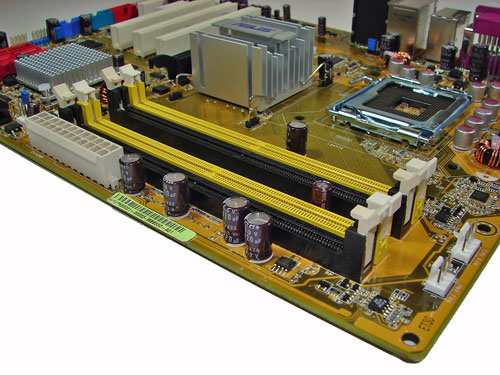
The DIMM module slots' color coordination is correct for dual channel setup based upon the premise of installing DIMMs in the same colored slots for dual-channel operation. The memory modules are slightly difficult to install with a full size video card placed in the PCI Express x16 slot. The 24-pin ATX power connector is located along the edge of the board along with a series of capacitors for the memory modules. We would have moved the 24-pin ATX connector to the upper right corner of the board to allow for easier access to the memory modules and CPU area in our case. It would also help to facilitate installation of PSUs with cables that are not longer than normal.
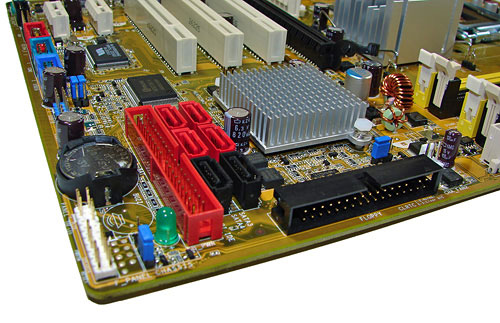
The four primary Intel ICH8R SATA ports are red along with the two secondary ports being black. These ports are conveniently located to the left of the ICH8R Southbridge and right of the battery and IDE port connector. We found the positioning of the SATA ports to be excellent when utilizing either the PCI-E x1 or PCI 2.3 slots. The ICH8R is passively cooled with a low rise heatsink and remained cool to the touch throughout testing.
The black floppy drive connector is located on the edge of the board and should have been switched with IDE port connector, as IDE cables are used far more than floppy cables these days. This switch would have eased installation of the IDE cable when using both the IDE and SATA ports. The clear CMOS jumper is color coded blue and is located in between the floppy drive connector and ICH8R chipset. This jumper was very difficult to use when utilizing a double slot video card. The chassis panel is located at the far left corner of the board.
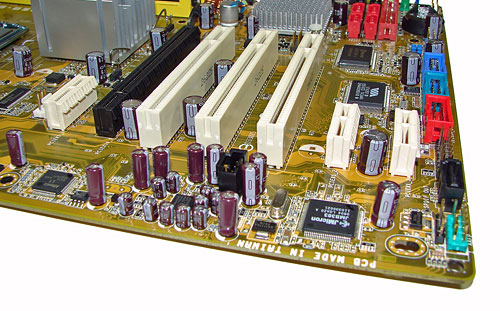
The board comes with (1) physical PCI Express x16 connector, (3) PCI Express x1 connectors, and (3) PCI 2.3 connectors. The layout of this design offers an excellent balance of expansion slots and provides very good clearance for most of the slots. When utilizing a double slot video card the first PCI slot is physically blocked and cannot be used. However, this still leaves two open PCI slots for use and all three PCI Express x1 slots. The black JMicron SATA port is on the right edge of the board along with the Firewire, COM1, and USB headers.
Returning to the CPU socket area, we find an ample amount of room for alternative cooling solutions that include most air and water cooling solutions. The Intel P965 MCH chipset is passively cooled with a mid-rise heatsink that did not interfere with any installed peripherals. This heatsinsk kept the MCH temperatures in check so that additional chipset voltage was not a factor in our overclocking tests. ASUS places the 4-pin ATX connector in the upper right section of the board and out of the way of the CPU area.
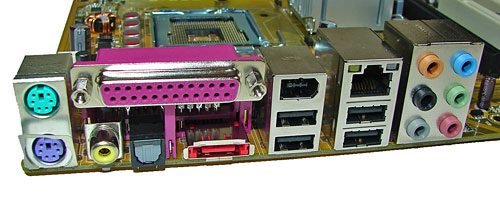
The rear panel contains the standard PS/2 mouse and keyboard, Parallel, LAN, and four USB 2.0 ports. The LAN (RJ-45) port has two LED indicators representing Activity and Speed of the connection through the Attansic L1 Gigabit PCI-E chipset. The audio panel consists of 6 ports that can be configured for 2, 4, 6, and 8-channel audio connections for the ADI 1988A HD codec. The panel also has two S/PDIF (optical out/coaxial out) ports, and an external SATA 3Gb/s port via the JMicron JMB383 chipset.
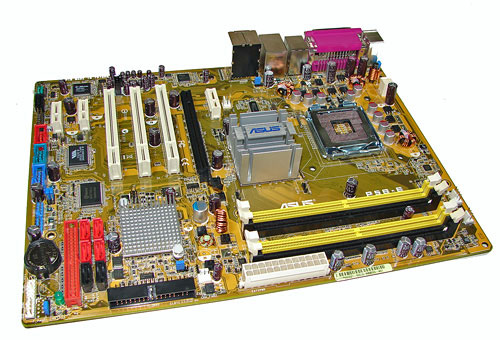 |
| Click to enlarge |
After viewing the Abit AB9-Pro, the layout on the ASUS seems almost mundane. However, we have no real complaints about the layout except for the location of the IDE port and 24-pin ATX power connector. We feel like the IDE port connector should have been placed next to the floppy drive connector or replaced it. It would have been nice to have the 24-pin ATX connector located further to the right behind the memory slots. The motherboard was very easy to install and remove from our case. The four fan headers were within easy reach and can be controlled by the Q-Fan utility. The P5B-E replaces the P5B model. We tested both the 1.01G and 1.02G revision level boards and they are identical except for the BIOS changes and a PLL controller. Both boards feature an excellent three-phase voltage regulator power design along with high quality capacitors that yielded exceptional stability.

The DIMM module slots' color coordination is correct for dual channel setup based upon the premise of installing DIMMs in the same colored slots for dual-channel operation. The memory modules are slightly difficult to install with a full size video card placed in the PCI Express x16 slot. The 24-pin ATX power connector is located along the edge of the board along with a series of capacitors for the memory modules. We would have moved the 24-pin ATX connector to the upper right corner of the board to allow for easier access to the memory modules and CPU area in our case. It would also help to facilitate installation of PSUs with cables that are not longer than normal.

The four primary Intel ICH8R SATA ports are red along with the two secondary ports being black. These ports are conveniently located to the left of the ICH8R Southbridge and right of the battery and IDE port connector. We found the positioning of the SATA ports to be excellent when utilizing either the PCI-E x1 or PCI 2.3 slots. The ICH8R is passively cooled with a low rise heatsink and remained cool to the touch throughout testing.
The black floppy drive connector is located on the edge of the board and should have been switched with IDE port connector, as IDE cables are used far more than floppy cables these days. This switch would have eased installation of the IDE cable when using both the IDE and SATA ports. The clear CMOS jumper is color coded blue and is located in between the floppy drive connector and ICH8R chipset. This jumper was very difficult to use when utilizing a double slot video card. The chassis panel is located at the far left corner of the board.

The board comes with (1) physical PCI Express x16 connector, (3) PCI Express x1 connectors, and (3) PCI 2.3 connectors. The layout of this design offers an excellent balance of expansion slots and provides very good clearance for most of the slots. When utilizing a double slot video card the first PCI slot is physically blocked and cannot be used. However, this still leaves two open PCI slots for use and all three PCI Express x1 slots. The black JMicron SATA port is on the right edge of the board along with the Firewire, COM1, and USB headers.
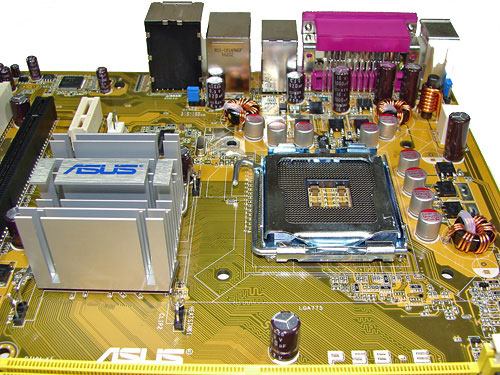 |
| Click to enlarge |
Returning to the CPU socket area, we find an ample amount of room for alternative cooling solutions that include most air and water cooling solutions. The Intel P965 MCH chipset is passively cooled with a mid-rise heatsink that did not interfere with any installed peripherals. This heatsinsk kept the MCH temperatures in check so that additional chipset voltage was not a factor in our overclocking tests. ASUS places the 4-pin ATX connector in the upper right section of the board and out of the way of the CPU area.

The rear panel contains the standard PS/2 mouse and keyboard, Parallel, LAN, and four USB 2.0 ports. The LAN (RJ-45) port has two LED indicators representing Activity and Speed of the connection through the Attansic L1 Gigabit PCI-E chipset. The audio panel consists of 6 ports that can be configured for 2, 4, 6, and 8-channel audio connections for the ADI 1988A HD codec. The panel also has two S/PDIF (optical out/coaxial out) ports, and an external SATA 3Gb/s port via the JMicron JMB383 chipset.










62 Comments
View All Comments
powchi - Monday, October 23, 2006 - link
Thanks Jarred, lopri, Aikouka for the reply.Kougar - Saturday, October 21, 2006 - link
I am rather puzzled. As best I can tell from Google, my kit of Corsair TWIN2X2048-6400 does use Micron D9s...... but I use a Gigabyte DS3 and even with the awful release F1 BIOS onwards have had no issues using them. Currently I have a stable OC of 501FSB for a 3.5ghz rating on the old F6 BIOS. Can you confirm if this kit of RAM uses D9's or not, because I am running the 800mhz RAM at 1ghz, 2 or 2.1v only, 5-5-5-15 timings, 24 hour dual Prime stable?? I have a kit of Corsair 6400c4 on the way, so I guess this will prove interesting either way.
I would also like to clarify that with the hours upon hours I spent playing around with and overclocking the DS3, I only once experienced a situation where I had to use the BIOS jumper, as I had managed to lock it into a POST/rebooting cycle. Having only used a Abit IS7 before, I can say it was a major difference I quickly noticed.
Thanks for any info, it's appreciated. And good article, by the way!
Gary Key - Saturday, October 21, 2006 - link
Are your 6400's the 6400 plain or 6400C4? There is a difference between the IC chips used.
We have one set of Micron D9 1GB that work properly in this board but they cost about $650 right now and had a beta SPD. We do not have every D9 1GB module available for testing but the 14 we have tried resulted in failure. Some would do 445, some would do 465. Just about every DS3 owner I know has an issue with the recent D9 1G modules not reaching 500FSB at 1:1 in a stable manner. We even tried three different boards during testing. I was able to hit 510 with the 512MB D9 and some beta 1GB Elpedia sticks from OCZ. Gigabyte agrees with our findings and it should be solved shortly.
We really like the DS3, it proved to be a very stable board in testing. As I stated at the end, this board has changed our opinion about Gigabyte again.
Thanks for the comments. :)
John - Sunday, October 22, 2006 - link
Gary, have you tested G.SKILL 2GB (2 x 1GB) F2-6400PHU2-2GBHZ modules on the DS3? If not please add these to your list. This is some extremely popular Micron D9 memory with favorable reviews on Newegg and our forums.Kougar - Sunday, October 22, 2006 - link
I am currently using the basic 5-5-5-12 1.9v vanilla 6400 kit, not the 6400c3 or the 6400c4. Could you please tell me which of these uses the Micron D9s, since from what you are saying I've only found incorrect info! Thanks for fully explaining this issue with the D9's in your reply, as I did not know Anandtech had tested not one or even two but three DS3's and a whopping 14 modules! So do you know if both the "c3" and "c4" use the Micron D9s, then? I've already ordered the 6400c4 kit, so I am getting the feeling I am in for a rude surprise!
I'm grateful to know that y'all are keeping ontop of the situation, this does go a long way to explaining the extremely large disparity in user results I've read or come across about the DS3. And I'm grateful Gigabyte is working to solve this issue, the user support and countless BIOS work from them is not something I was ever expecting... it's gone a long way to putting them on my top picks list.
And I believe I should be thanking you for the reply. ;)
jonp - Saturday, October 21, 2006 - link
-- on the second memory chart it always says "4/4 slots populated - 1 Dual-Channel Bank". If all four slots are populated with the same memory, why does it say "1" Dual-Channel Bank?-- I can only find the GEIL memory at one on-line merchant (via froogle or pricewatch) at $460 for 2GB. That would be $920 for 4GB! it would have been nice if you had also picked a less expensive memory that more of us could afford.
-- ASUS making a significant change to their product and only changing the version makes it VERY hard (impossible) to on-line order the specific product desired. newegg says order and if wrong, they will exchange...but that gets expensive too... and takes at least 7 days turnaround; and no guarantee that it will be the right one even then.
thanks for the article...it was, as always, full of useful data and observations.
Gary Key - Saturday, October 21, 2006 - link
1. The charts have been corrected. I stated this above but Jarred and I were editing at the same time on some pages and we did an overwrite on each other's corrections a couple of times. We learned our lesson after the Biostar section turned into the ASUS section. ;-)2. When we started this article the GEIL and G.Skill PC2-6400 that we used was in the $269~$289 range for a 2GB kit. This was far below the $500+ prices that our OCZ and Corsair memory modules had reached at that time. I am trying to create a memory table at this time as the boards were tested with everything from A-Data DDR2-533 to OCZ PC2-8000VX2. Our intentions were to use mid-range PC2-6400 memory when we started but it appears we chose some memory that is in very high demand and short supply now.
3. As I stated in the article, ASUS will probably call the 1.02G board something else. The 1.01G board is not a slacker. :)
Thank you for the comments, we appreciate them.
Aikouka - Saturday, October 21, 2006 - link
After going through about 4 or so of the motherboards and looking at their windows programs... I just gotta rant.Why in God's name must motherboard manufacturers make their programs SO UGLY? I'm no Martha Stewart, but even I can see that those programs are attrocious to look at and I actually don't install those cheesy programs because of how horrible they look. I prefer a normal streamlined windows look to my programs, hence why I use the Windows Classic theme. But even if your preference isn't a normal streamlined windows look, I don't see how anyone could find those horrid looking things called applications desirable.
Nakazato - Saturday, October 21, 2006 - link
it's Taiwanese tradition. For the people above... the S3 does not overclock as well as the DS3, it's very noticable. The DQ6 is in theory better than the DS3, but may hardly be noticable and when it is, it's probably just luck of the draw.My only criticism of the review is that only one memory module type was used and that I know other reviews on AT have included some other comparisons... but your review is more recent with more of the facts in(so more relevant). I know you had some references in the article and I know that the Micron chips are the best on average, but on occasion some chips perform better on a per board basis and not just on a per chipset basis.
Review does get 2 thumbs up from me though. The extra side information(EAX2 Support of onboard sound drivers, Micron D9 chips not fully supported, but will be, etc) helps make buying decisions. Thanks for the article!
Aikouka - Sunday, October 22, 2006 - link
Gah, how can such an ugly thing be tradition. It honestly detracts from the overall computing experience having something so tastelessly crafted. I guess to each his own :/